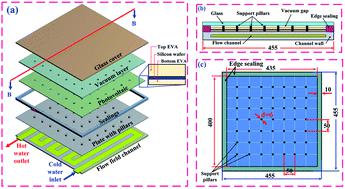当前位置:
X-MOL 学术
›
Sustain. Energy Fuels
›
论文详情
Our official English website, www.x-mol.net, welcomes your
feedback! (Note: you will need to create a separate account there.)
Development of a new vacuum-based photovoltaic/thermal collector, and its thermal and exergy analyses
Sustainable Energy & Fuels ( IF 5.0 ) Pub Date : 2020-10-19 , DOI: 10.1039/d0se01102a Ali Radwan 1, 2, 3, 4, 5 , Takao Katsura 1, 2, 3, 4, 5 , Saim Memon 6, 7, 8, 9, 10 , Essam M. Abo-Zahhad 11, 12, 13, 14, 15 , O. Abdelrehim 2, 11, 15, 16, 17 , Ahmed A. Serageldin 1, 2, 3, 4, 5 , Mohamed R. Elmarghany 2, 11, 15, 16, 17 , Asmaa Khater 2, 11, 15, 16, 17 , Katsunori Nagano 1, 2, 3, 4, 5
Sustainable Energy & Fuels ( IF 5.0 ) Pub Date : 2020-10-19 , DOI: 10.1039/d0se01102a Ali Radwan 1, 2, 3, 4, 5 , Takao Katsura 1, 2, 3, 4, 5 , Saim Memon 6, 7, 8, 9, 10 , Essam M. Abo-Zahhad 11, 12, 13, 14, 15 , O. Abdelrehim 2, 11, 15, 16, 17 , Ahmed A. Serageldin 1, 2, 3, 4, 5 , Mohamed R. Elmarghany 2, 11, 15, 16, 17 , Asmaa Khater 2, 11, 15, 16, 17 , Katsunori Nagano 1, 2, 3, 4, 5
Affiliation

|
Photovoltaic–thermal (PV/T) solar collectors convert solar radiation into electrical power and heat. Part of received solar energy can be lost to the atmosphere from the top surface of the PV/T module, especially in windy regions. Thus, in this study, a new vacuum-based photovoltaic thermal (VPV/T) collector is designed and comparatively analyzed with the conventional PV/T collector. The new design differs from the conventional PV/T design by including a vacuum layer above the silicon wafer. Besides, to enhance the heat dissipation from the silicon wafer in the VPV/T design to the thermal absorber, the thicknesses of ethylene-vinyl acetate and tedlar polyester tedlar layers underneath the silicon wafer are decreased. A comprehensive 3D conjugate thermal model is developed and validated. The comparison is conducted under steady and transient conditions. The effects of Reynolds number (Re), wind speed, glass emissivity, and vacuum pressure are investigated. And finally, exergy analysis results for both designs are compared. The results showed that the new VPV/T collector has accomplished a 26.6% increase in the thermal power without changing the electrical power gain at Re of 50 and solar irradiance of 1000 W m−2. In addition, the vacuum pressure degradation from 0.01 Pa to 10 Pa slightly decreases the gained thermal power of the new VPV/T collector. A further increase in the vacuum pressure from 10 Pa to 1.013 × 105 Pa significantly decreases the gained thermal power with a slight increase in the electrical power. Furthermore, the total predicted VPV/T and the conventional PV/T exergy efficiency are 39.6% and 32%, respectively.
中文翻译:

新型基于真空的光伏/集热器的开发及其热能和火用分析
光伏热(PV / T)太阳能集热器将太阳辐射转化为电能和热量。接收到的太阳能的一部分可能会从PV / T模块的顶面散失到大气中,特别是在大风区域。因此,在这项研究中,设计了一种新型的基于真空的光伏热能(VPV / T)收集器,并与常规PV / T收集器进行了比较分析。新设计与常规PV / T设计的不同之处在于,在硅晶圆上方包括一个真空层。此外,为了增强从VPV / T设计中的硅晶片到吸热器的散热,减小了硅晶片下方的乙烯-乙酸乙烯酯和tedlar聚酯tedlar层的厚度。开发并验证了全面的3D共轭热模型。比较是在稳定和瞬态条件下进行的。研究了雷诺数(Re),风速,玻璃发射率和真空压力的影响。最后,比较了两种设计的火用分析结果。结果表明,新的VPV / T收集器在不改变Re为50和太阳辐照度为1000 W m的情况下获得的热功率增加了26.6%。−2。此外,真空压力从0.01 Pa降到10 Pa会稍微降低新型VPV / T集热器获得的热功率。真空压力从10 Pa进一步增加到1.013×10 5 Pa会显着降低获得的热功率,同时电功率会略有增加。此外,总的预测VPV / T和常规PV / T的火用效率分别为39.6%和32%。
更新日期:2020-11-12
中文翻译:

新型基于真空的光伏/集热器的开发及其热能和火用分析
光伏热(PV / T)太阳能集热器将太阳辐射转化为电能和热量。接收到的太阳能的一部分可能会从PV / T模块的顶面散失到大气中,特别是在大风区域。因此,在这项研究中,设计了一种新型的基于真空的光伏热能(VPV / T)收集器,并与常规PV / T收集器进行了比较分析。新设计与常规PV / T设计的不同之处在于,在硅晶圆上方包括一个真空层。此外,为了增强从VPV / T设计中的硅晶片到吸热器的散热,减小了硅晶片下方的乙烯-乙酸乙烯酯和tedlar聚酯tedlar层的厚度。开发并验证了全面的3D共轭热模型。比较是在稳定和瞬态条件下进行的。研究了雷诺数(Re),风速,玻璃发射率和真空压力的影响。最后,比较了两种设计的火用分析结果。结果表明,新的VPV / T收集器在不改变Re为50和太阳辐照度为1000 W m的情况下获得的热功率增加了26.6%。−2。此外,真空压力从0.01 Pa降到10 Pa会稍微降低新型VPV / T集热器获得的热功率。真空压力从10 Pa进一步增加到1.013×10 5 Pa会显着降低获得的热功率,同时电功率会略有增加。此外,总的预测VPV / T和常规PV / T的火用效率分别为39.6%和32%。











































 京公网安备 11010802027423号
京公网安备 11010802027423号